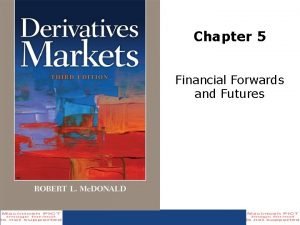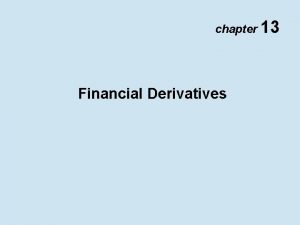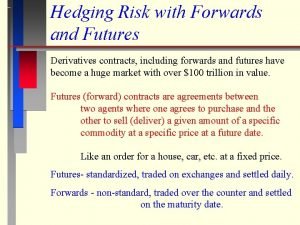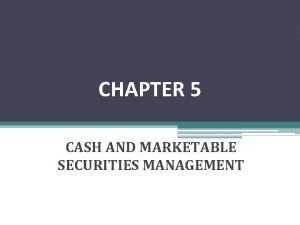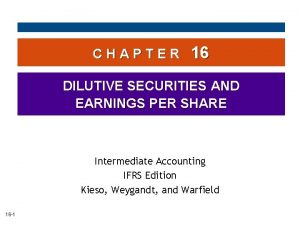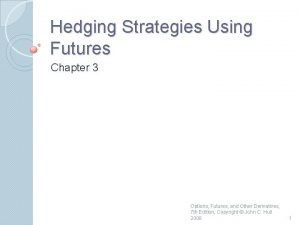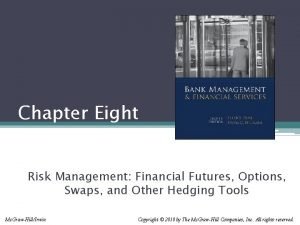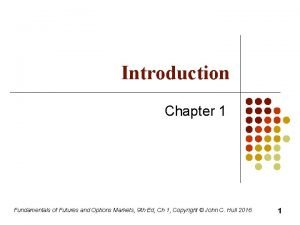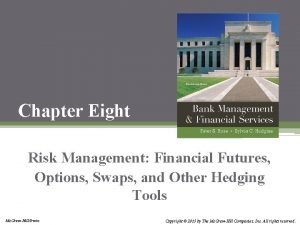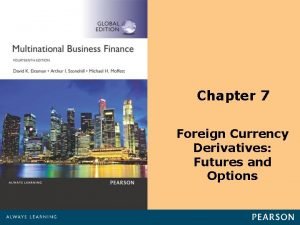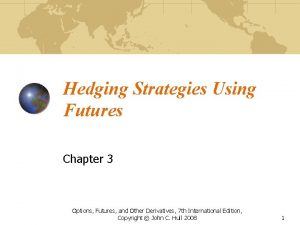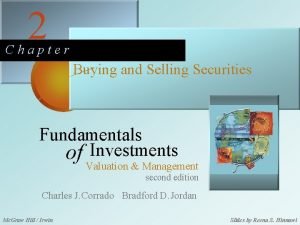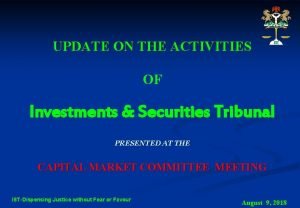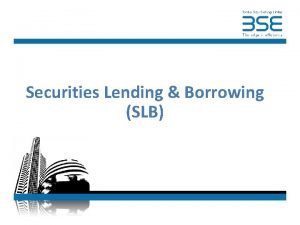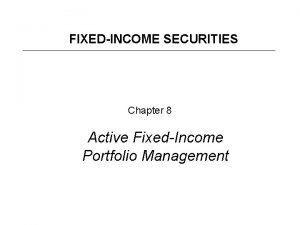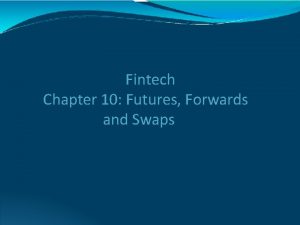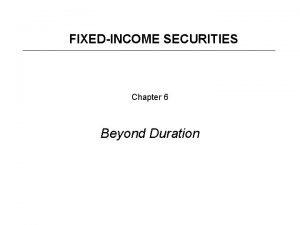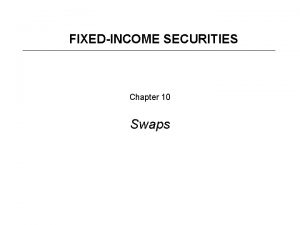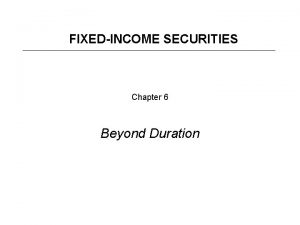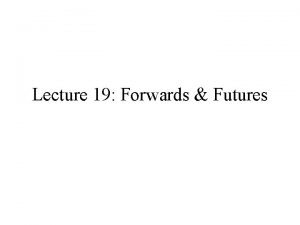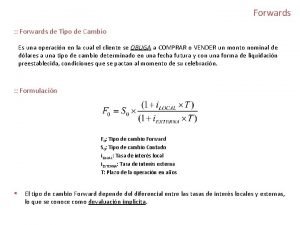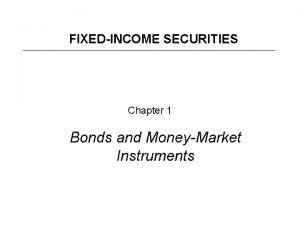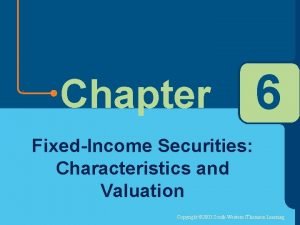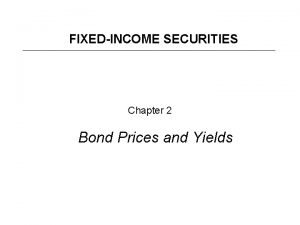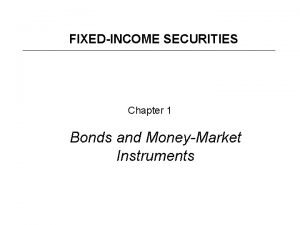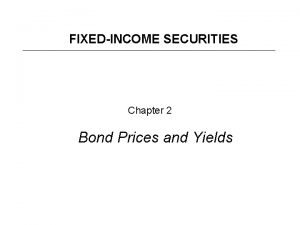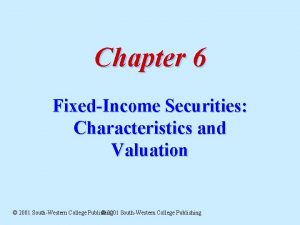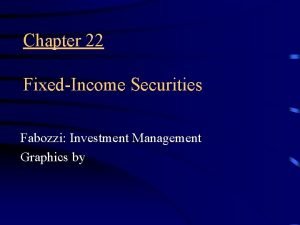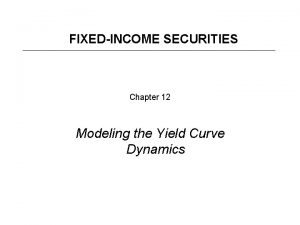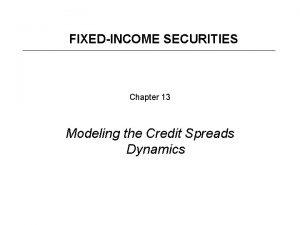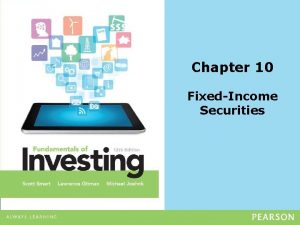FIXEDINCOME SECURITIES Chapter 11 Forwards and Futures Outline























- Slides: 23

FIXED-INCOME SECURITIES Chapter 11 Forwards and Futures

Outline • • • Futures and Forwards Types of Contracts Trading Mechanics Trading Strategies Futures Pricing Uses of Futures

Futures and Forwards • Forward – An agreement calling for a future delivery of an asset at an agreedupon price • Futures – Similar to forward but feature formalized and standardized characteristics • Key differences in futures – – Secondary market - liquidity Marked to market Standardized contract units Clearinghouse warrants performance

Key Terms for Futures Contracts • Futures price: agreed-upon price (similar to strike price in option markets) • Positions – Long position - agree to buy – Short position - agree to sell • Interpretation – Long : believe price will rise (or want to hedge price decline) – Short : believe price will fall (or want to hedge price increase) • Profits on positions at maturity (zero-sum game) – Long = spot price ST minus futures price F 0 – Short = futures price F 0 minus spot price ST

Markets for Interest Rates Futures • The International Money Market of the Chicago Mercantile Exchange (www. cme. com) • The Chicago Board of Trade (www. cbot. com) • The Sydney Futures Exchange • The Toronto Futures Exchange • The Montréal Stock Exchange • The London International Financial Futures Exchange (www. liffe. com) • The Tokyo International Financial Futures Exchange (TIFFE) • Le Marché à Terme International de France (www. matif. fr) • Eurex (www. eurexchange. com)

Instruments

Characteristics of Future Contracts • A future contract is an agreement between two parties • The characteristics of this contract are – – – The underlying asset The contract size The delivery month The futures price The initial regular margin

Underlying Asset and Contract Size • The underlying asset that the seller delivers to the buyer at the end of the contract may exist (interest rate) or may not exist (bond) – The underlying asset of the CBOT 30 -Year US Treasury bond future is a fictive 30 -year maturity US Treasury bond with 6% coupon rate • The contract size specifies the notional principal or principal value of the asset that has to be delivered – The notional principal of the CBOT 30 -Year US Treasury bond future is $100, 000 – The principal value of the Matif 3 -month Euribor Future to be delivered is euros 1, 000

Price • The futures price is quoted differently depending on the nature of the underlying asset – When the underlying asset is an interest rate, the future price is quoted to the third decimal point as 100 minus this interest rate – When the underlying asset is a bond, it is quoted in the same way as a bond, i. e. , as a percentage of the nominal value of the underlying • The tick is the minimum price fluctuation that can occur in trading • Sometimes daily price movement limits as well as position limits are specified by the exchange

Trading Arrangements • Clearinghouse acts as a party to all buyers and sellers – Obligated to deliver or supply delivery • Initial margin – Funds deposited to provide capital to absorb losses • Marking to market – Each day profits or losses from new prices are reflected in the account • Maintenance or variation margin – An established margin below which a trader’s margin may not fall • Margin call – When the maintenance margin is reached, broker will ask for additional margin funds

Conversion Factor • When the underlying asset of a future contract does not exist, the seller of the contract has to deliver a real asset – May differ from the fictitious asset in terms of coupon rate – May differ from the fictitious asset in terms of maturity • Conversion factor tells you how many units of the actual asset are worth as much as one unit of the fictive underlying asset • Given a future contract and an actual asset to deliver, it is a constant factor which is known in advance • Conversion factors for next contracts to mature available on web sites of futures markets

Conversion Factor (Cont’) • Consider – A future contract whose fictitious underlying asset is a m year maturity bond with a coupon rate equal to r – Suppose that the actual asset delivered by the seller of the future contract is a x-year maturity bond with a coupon rate equal to c • Expressed as a percentage of the nominal value, the conversion factor denoted CF is the present value at maturity date of the future contract of the actual asset discounted at rate r • Example – Consider a 1 year future contract whose underlying asset is a fictitious 10 year maturity bond with a 6% annual coupon rate – Suppose that the asset to be delivered is at date 1 a 10 -year maturity bond with a 5% annual coupon rate

Invoice Price • The conversion factor is used to calculate the invoice price – Price the buyer of the future contract must pay the seller when a bond is delivered – IP = size of the contrat x [futures price x CF] • Example – Suppose a future contract whose contract size is $100, 000, the future price is 98. The conversion factor is equal to 106. 459 and the accrued interest is 3. 5. – The invoice price is equal to IP = $100, 000 x [ 98% x 106. 459% + 3. 5% ] = $104, 329. 82

Cheapest-to-Deliver • At the repartition date, there are in general many bonds that may be delivered by the seller of the future contract • These bonds vary in terms of maturity and coupon rate • The seller may choose which of the available bonds is the cheapest to deliver • Seller of the contract delivers a bond with price CP and receives the invoice price IP from the buyer • Objective of the seller is to find the bond that achieves Max (IP - CP) = Max (futures price x CF – quoted price)

Cheapest-to-Deliver (Example) • Suppose a future contract – Contract size = $100, 000 – Price= 97 • Three bonds denoted A, B and C Bond A Bond B Bond C Quoted Price Conversion Factor IP-CP 103. 90 118. 90 131. 25 107. 145% 122. 512% 135. 355% 3, 065$ -6, 336$ 4, 435$ • Search for the bond which maximises the quantity IP-CP • Cheapest to deliver is bond C

Forward Pricing • Consider at date t an investor who wants to hold at a future date T one unit of a bond with coupon rate c and time t price Pt • He faces the following alternative cash flows – Either he buys at date t a forward contract from a seller who will deliver at date T one unit of this bond at a fixed price Ft – Or he borrows money at a rate r to buy this bond at date t -

Forward Pricing • Note that both trades have a cost equal to zero at date t. • Note also that the position at the end is the same (one unit of bond). • Then in the absence of arbitrage opportunities, the value of the two strategies at date t must be equal • From this we obtain or with R = 365 r/360 and C = 100 c/Pt

Forward Pricing - Example • On 05/01/01, we consider a forward contract maturing in 6 months, written on a bond whose coupon rate and price are respectively 10% and $115 • Assuming a 7% interest rate, the forward price F 05/01/01 is equal to

Forward Pricing – Underlying is a Rate • Simply determine the forward rate that can be guaranteed now on a transaction occurring in the future • Example – An investor wants now to guarantee the one-year zero-coupon rate for a $10, 000 loan starting in 1 year • Either he buys a forward contract with $10, 000 principal value maturing in 1 year written on the one-year zero-coupon rate R(0, 1) at a determined rate F(0, 1, 1), which is the forward rate calculated at date t=0, beginning in 1 year and maturing 1 year after • Or he simultaneously borrows and lends $10, 000 repayable at the end of year 2 and year 1, respectively • This is equivalent to borrowing $10, 000 x[1+R(0, 1)] in one year, repayable in two years as $10, 000 x(1+R(0, 2))2. – The implied rate on the loan given by the following equation is the forward rate F(0, 1, 1)

Futures Pricing • Price futures contracts by using replication argument, just like forward contracts • Let’s consider two otherwise identical forward and futures contracts – Cash-flows are not identical because gains and losses in futures trading are paid out at the end of the day – Denoted as G 0 and F 0, respectively, current forward and futures prices • When interest rates are changing randomly – Cannot create a replicating portfolio – Cannot price futures contracts by arbitrage • However, short term bond prices are very insensitive to interest rate movements – Replication argument is almost exact

Futures versus Forward Pricing

Uses of Futures • Fixing today the financial conditions of a loan or investment in the future • Hedging interest rate risk – Because of high liquidity and low cost due to low margin requirements, futures contracts are actually very often used in practice for hedging purposes – Can be used for duration hedging or more complex hedging strategies (see Chapters 5 and 6) • Pure speculation with leverage effect – Like bonds, futures contracts move in the opposite direction to interest rates – This is why a speculator expecting a fall (rise) in interest rates will buy (sell) futures contracts – Advantages : leverage, low cost, easy to sell short

Uses of Futures – Con’t • Detecting riskless arbitrage opportunities using futures • Cash-and-carry arbitrage – Consists in buying the underlying asset and selling the forward or futures contract – Amounts to lending cash at a certain interest rate X – There is an arbitrage opportunity when the financing cost on the market is inferior to the lending rate X • Reverse cash-and-carry – Consists in selling (short) the underlying asset and buying the forward or futures contract – Amounts to borrowing cash at a certain interest rate Y – There is an arbitrage opportunity when the investment rate on the market is superior to the borrowing rate Y
 Futures and forwards
Futures and forwards Forwards vs futures vs options vs swaps
Forwards vs futures vs options vs swaps Fx forwards manchester
Fx forwards manchester Hedging with forward contracts
Hedging with forward contracts Equity forward
Equity forward Mercados de forwards y swaps
Mercados de forwards y swaps Bottle of rum to fill my tum
Bottle of rum to fill my tum What are marketable securities
What are marketable securities Dilutive securities and earnings per share
Dilutive securities and earnings per share Quote sandwich example
Quote sandwich example Tailing a hedge
Tailing a hedge Options futures and risk management
Options futures and risk management Options futures and other derivatives
Options futures and other derivatives Fundamentals of futures and options markets
Fundamentals of futures and options markets Options futures and risk management
Options futures and risk management Currency futures and options
Currency futures and options Hedging strategies using futures and options
Hedging strategies using futures and options Buying and selling of securities
Buying and selling of securities Cisi introduction to securities and investment
Cisi introduction to securities and investment Buying and selling of securities
Buying and selling of securities Cash and marketable securities
Cash and marketable securities Investment and securities tribunal
Investment and securities tribunal Sds security
Sds security Securities lending and borrowing example
Securities lending and borrowing example
